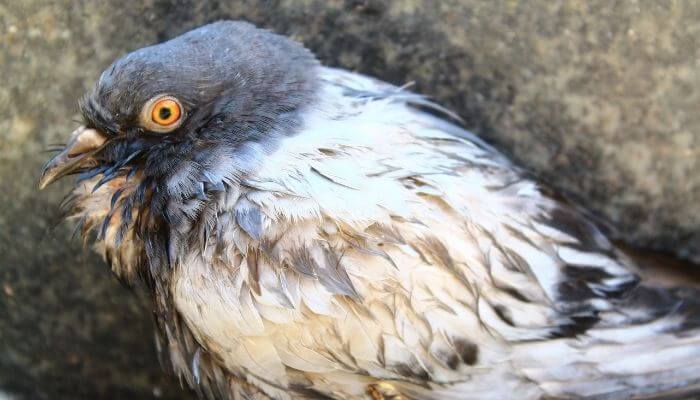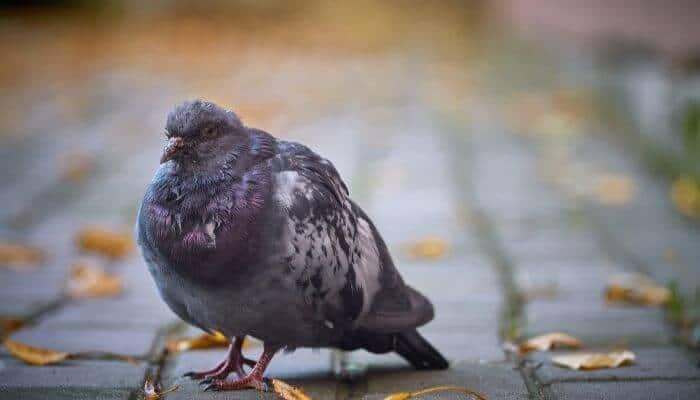Although it might not seem like the most common disease that can affect pigeons, Hexamitiasis can still happen, and the worst thing about it is that there are no specific medications or vaccines against it.
In today’s article, we’re looking at how Hexamitiasis affects pigeons, its symptoms, diagnosis, and if there are any ways to prevent it.
What Causes Hexamitiasis In Pigeons?
This infectious condition is caused by a protozoan called Spironucleus meleagridis. The pathogen affects a variety of bird species, from turkeys and peafowl to quail.
Pigeons get the disease by becoming infected with a different strain, called Spironucleus columbae. To date, there have been no cases reported in chickens.
Although less common in North American countries such as Canada and the United States, this infectious disease does tend to affect pigeons across the rest of the world, including the United Kingdom and the Netherlands.
Pigeons can become infected with the pathogen by coming in contact with other birds’ feces.
This is what makes preventing and treating Hexamitiasis so challenging — even if you practice excellent hygiene, wear gloves, and regularly clean your pigeons’ living enclosures, when they go out and fly, they can still come in contact with other infected birds.
And once one of your pigeons becomes sick, it can effectively spread the condition to any of the other pigeons they live close to.
The birds inadvertently come in contact with their own feces and can infect food and water, which are two other possible ways they become infected — by essentially ingesting the pathogen.
Clinical signs
Any of the birds that might have become infected with this pathogen might initially show a number of symptoms that aren’t necessarily specific to the disease, such as the following:
- Depression
- Lack of appetite
- Weight loss
- Ruffled feathers
Shortly after the pigeons begin showing these general clinical signs, they start to have watery, green diarrhea and dehydrate.

Considering that they also lose their appetite for both food and water, it goes without saying that if they do not receive immediate treatment, they can show additional symptoms, such as convulsions.
They can also die in a matter of several days after the initial signs become noticeable.
What Pigeons Does Hexamitiasis Affect?
Adults can be carriers without showing any clinical signs, and that’s thanks to a fully developed immune system.
However, the category of pigeons that this disease tends to affect the most are young ones, especially those younger than 12 weeks of age.
Because they are far more sensitive to any pigeon disease compared to adults, young pigeons tend to develop much more severe symptoms compared to their older counterparts.
For this reason, Hexamitiasis can be a life-threatening condition for them.
The same rule applies for pigeons that were recently carried to competitions as they had to be transported in close proximity to other birds and they might have also become stressed.
This means that their immune system is less capable of handling the abuse of the pathogen.
Diagnosis of Hexamitiasis In Pigeons
People who love and keep pigeons might be tempted to think that they can use just any type of medication against the symptoms that the disease causes. Unfortunately, this is not true.
Protozoal infections are quite different from regular bacterial ones, which means that your vet needs to prescribe specific medication to alleviate the clinical signs.
The veterinarian can also advise you on what you are supposed to do to limit the spread of the disease between your pigeons.
In any case, the diagnosis of Hexamitiasis almost always involved a fecal examination.
A fresh cloacal swab can be quite revealing in this sense, but veterinary professionals can use other diagnostic methods such as wet mount cytology and Giemsa staining used on the samples they have collected.
However, since the protozoan doesn’t have good survival times in the outdoors, if one of your pigeons has died, you might have to take it to the animal clinic so that the vet can perform intestinal scraping, whether of the jejunal or duodenal mucosa.
Moreover, a differential diagnosis (especially based on the clinical findings) must be performed between hexamitiasis and other diseases, such as the following:
- Histomoniasis
- Trichomoniasis
- Paratyphoid
Can Hexamitiasis Be Treated?
In the United Kingdom, this disease used to be treated by the administration of Emtryl, an in-feed dimetridazole medication.
Unfortunately, the drug has been withdrawn from use, and giving them to birds has now become illegal as it has a wide variety of side effects.
In Belgium, a combination of Spartrix and Ronidazole is currently being used to treat Hexamitiasis, and it seems to be quite effective.
The medication has to be administered over the course of at least one week in order to do its job properly.

Ronidazole is a drug that can also be used for preventing Hexamitiasis, as well as other conditions, such as trichomoniasis.
Besides these synthetic medications, pigeon aficionados can also use a combination of herbal extracts commercially known as Travipharma Travi-Allicin-Plus.
This product is specifically manufactured for pigeons, and it contains a number of plant extracts (such as Echinacea, licorice, and Allium sativum), as well as vitamin B2.
The medication itself cannot be used to treat acute forms of Hexamitiasis, but when it is administered alongside other therapies, it can help with prevention, and in the event of an ongoing infection, it can provide some support to the birds’ immune system.
Even though a specific treatment for pigeon Hexamitiasis does not exist, antibiotics tend to offer good results.
This happens because of the lesions that the protozoan causes on the birds’ gastrointestinal system, which can often be entryways for potentially pathogenic bacteria.
Prevention
This protozoan parasite is extremely common and can be carried by pigeons and other wild birds, which means that preventing the infection can be extremely challenging.
However, practicing excellent hygiene and making sure that you separate the birds that begin showing any symptoms from the rest of the pigeon population can be beneficial.
It’s also worth adding that Hexamitiasis tends to affect pigeons during specific periods.
If you have young pigeons and care for them, separating their families from the rest can prevent them from becoming infected.
Also, when the cold season starts, it is a good idea to make sure that your birds have access to hygienic feed and water supplies.
Using heating systems and making sure that your pigeons never get cold can make it possible for their immune systems to better cope with any potential infections, including those with Spironucleus columbae.
Another note we must make with regard to this pigeon disease is that the protozoan tends to survive better in wet environments.
For this reason, we suggest avoiding any wet areas around the drinkers or feeders as these are the two places where pigeons can become easily infected.
While this might mean that you have to check on these areas every day or even several times throughout the day, it is perhaps the best way of preventing Hexamitiasis.
Whenever introducing new pigeons into your population, make sure that you quarantine them for a week or two to make sure that they do not start showing any symptoms. Otherwise, you risk infecting all of the other birds, too.

This article was written by our qualified veterinarian Cristina.
This is part of our commitment to providing you with the most trustworthy veterinary advice for your pigeons.
Summary
Hexamitiasis is a protozoal disease that affects a variety of bird species, including pigeons.
Adults can be carriers of the protozoan without showing any specific symptom, although they release large amounts of the pathogen through their droppings.
The disease is especially dangerous for young and stressed pigeons. Talk to your vet about how you can prevent and treat this condition.
Sources:
